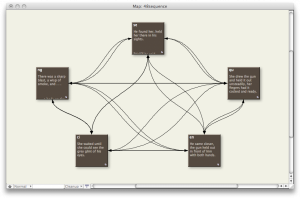100 DAYS PROJECT: #48
Sequencing
 This one is actually not as easy as it looks. There are two things I’ve followed here from Steve: the idea of the undead in his story is one thing.
This one is actually not as easy as it looks. There are two things I’ve followed here from Steve: the idea of the undead in his story is one thing.
The other? A challenge to write a five-space hypertext.
These two thoughts together come up with an unending supply of complete stories with no *particular beginning, ending or restriction of middle. Truly, a story to be written by the reader.
*Honest, your choice of click point actually starts the story in any of the five spaces.

 The Lost Children: A Charity Anthology
The Lost Children: A Charity Anthology
July 9th, 2009 at 9:33 pm
I didn’t check in yesterday because my initial reaction was confusion. Today it feels like a puzzle with an answer I’m not close to yet. I’ll let you know what tomorrow brings 🙂
July 10th, 2009 at 5:23 am
I’m very interested in your reactions to this. For me, it illustrates an inherent virtue of the hypertext form: total freedom of path with story intact. If you’ll notice, where you click on the title will bring you to a different entrance point. Where you leave the story is up to you as there is no exit point offered. The story then is entirely in your own control.
While this particular story may not be ideal, you have a Mexican standoff with the two characters with guns, and there is no real restriction as to whose body is on the floor–it could be one of them or neither but someone else. This writing space could end the story or it could start it. It is an exercise in endless story in the hypertext form.
July 10th, 2009 at 8:04 am
Oh, fun! I didn’t notice the title thing, that’s cool. (There is so much I fail to notice, sometimes I wonder why you still talk to me.) On the other side, there is still the “non-hypertexter’s lament”: what story are YOU trying to tell? I don’t know…
July 10th, 2009 at 9:01 am
Never mind, by the end of these 100 days you will be searching every word, every color, every letter in hypertext and make your teacher in Electric English swoon with delight.
As far as what I as author am trying to tell, well, it looks like Steve and I are really going to have to beat you with a stick and lock you in a room with a laptop that only has hypertext and Roland Barthes on the hard drive.
July 11th, 2009 at 10:03 pm
**feigning contrition** I will always be a writer at heart. This reader-is-owner stuff is really hard.
Funny story: today I went out with Kay and Yashodhara, my “old” writing friends, and I told them about this story, which is a perfect illustration of what makes hypertext fun and unique as a story vehicle. The inevitable comparison to Choose Your Own Adventures came up (remember when I said that?!) but in explaining this to them, I actually almost understood it!
…going back to playing the “In Your Pants” game now…
July 11th, 2009 at 10:15 pm
…after I tell you that Barthes is half right, half wrong. Why write it if you don’t have a reason? And why should that motivation become immaterial when I read it? What makes me an expert?
July 12th, 2009 at 7:55 am
What’s funny is that I went kicking and screaming into the concept of reader-written story; I wanted my words to be understood as I laid them out. Doesn’t everyone? But conversations are constantly changed because of interpretation and misinterpretation is not really a logical word! Like you, in trying to explain it to someone else, I understood it better myself. Score a point for knowledge being forced on a student without understanding it immediately.
Your reason for writing is irrelevant; you likely have a reason, but in fiction, who cares? What a reader will come out with is either a story he likes (the way he put it together, or a story he doesn’t like. What he’ll credit or blame, is the author.